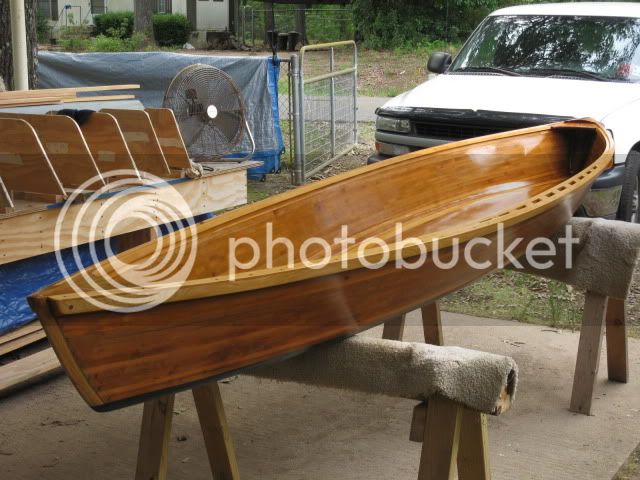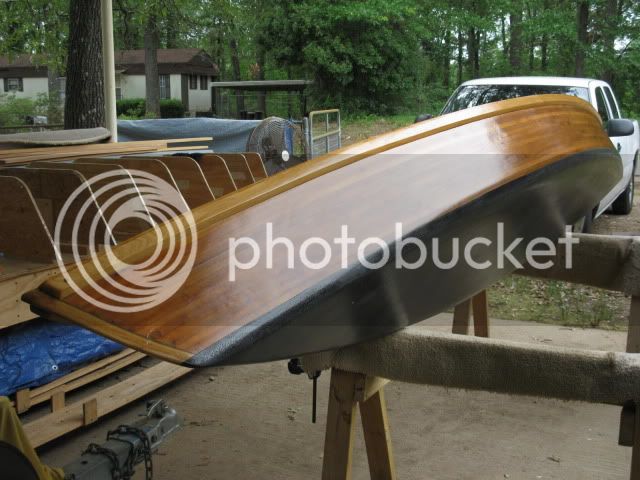My Strip Pirogue
- Thread starter beekeeper
- Start date
You are using an out of date browser. It may not display this or other websites correctly.
You should upgrade or use an alternative browser.
You should upgrade or use an alternative browser.
Nice to know you got 'er done. Now you can start doing the modifications. 


In my experience there are three things that somehow are never really DONE. A Ford PickUp, a wooden boat and a woman's wardrobe.
piper
In my experience there are three things that somehow are never really DONE. A Ford PickUp, a wooden boat and a woman's wardrobe.
piper
I've no experience with the first one, but can fully agree with numbers 2 and 3. sighislandpiper said:In my experience there are three things that somehow are never really DONE. A Ford PickUp, a wooden boat, and a woman's wardrobe.
seedtick said:your grandaughter doesn't have a boat
I was saving that reason for the "You don't need another boat, why are you building another one?" question. The grandkid answer works every time for Maw Maw bee. :roll:
beekeeper
And, for every other Grandmother in Creation! Bless their hearts.beekeeper said:I was saving that reason for the "You don't need another boat, why are you building another one?" question. The grandkid answer works every time for Maw Maw bee. :roll:
I don't get to help much on the building process, but will be happy to assist with the slime application process. I think it should take multiple coats and is best to apply liberally and frequently as the slime coat dries quickly and rapidly degrades in UV light. Don't forget your safety gear when applying the slime coats: PFD, sun screen, insect repellent. Some users complain of a fishy smell during the application process. If the smell bothers you, wear a respirator.
Took the boat out for another appliction of slime. Sliming realy is the best part of boat building. Was only able to apply a light coat (two small bass). That is OK. I'll just have to go again. Paddled farther than usual just looking around the bend, and putting in some seat time. I do like the light weight of this boat, loading and unloading. The boat has a different feel than my others. Seems to glide farther, and my be easier to paddle. It rocks more as you cast, or any other movements. I can't decide if the soft chines were worth the effort. Guess I will keep going until I know.
Six coats of varnish does not make for a slip resistant floor. It will get you nice compliments at the store.
beekeeper
Six coats of varnish does not make for a slip resistant floor. It will get you nice compliments at the store.
beekeeper
I like the ventilated gunnels. They are strong, light weight, and easy to dump out any water when you get back on shore.
I see there are no ribs on the bottom. Did you use something else to form the shape of the boat?
To the left of the boat is the strongback and stations with the forms used to build and shape the boat. It is strip built the same as a canoe or kayak. Hardest part was figuring the size and shape of the forms with out plans. I think when building "by hand and eye" the boat is shaped with movable jigs and then the ribs are added. Building with plans the size and shape of the ribs are known and are used to shape the boat. They act as jigs but only allow you to build to one known shape. Works ok with strip building or plywood. May not work with lumber because it may not conform to the ribs shape.
beekeeper
beekeeper
I thought that is what those might be but I thought also perhaps they went to another project. Is the bottom strips also?
Also handy for fish stringer or anchor tie off points. I chose to "ventilate" only the middle sections and was pleased with the look. Others may need them done the whole length of the boat, but I don.t venture very far from my seat.I like the ventilated gunnels. They are strong, light weight, and easy to dump out any water when you get back on shore.
Guillaume
The floor is strips. They were 3/8" but still needed two layers, one 6 oz. and one 10 oz., of glass on the inside to stiffen it enough to not need ribs.
beekeeper
Last edited:
I notice you have no thwarts. When studied, a thwart's primary function is to resist the sides pulling further apart in case of a folding disaster. F'rinstance, if the boat is bridged - both ends are well supported, and the center is bridged up with no support - any weight in the center (like, say, a fisherman trying to regain ewuilibrium, but stumbles) the ends of the boat can fold upwards, bending the middle of the hull open. An extreme example, the boat would fold completely double, and the ends would be nearly touching. While that isn't ever likely to happen, hull damage would probably occur in the first 5-10 degrees of bend.
A thwart resists the sides flexing outwards, and therefore resists hull deformation beyond the point where you hear loud cracks and pops.
All that being said, canoes and pirogues usually have thwarts made if wood. Wood will resist stress of both compression (sides squeezing closer together) and tension (sides are stretching further apart). Situations where the sides might squeeze closer together are both highly improbable, and fairly difficult to do. Therefore, an effective thwart need only withstand tension. Therefore wood is unnecessary as a thwart. ROPE, on the other hand, is a perfect thwart. Inexpensive, lightweight, and easily installed - especially onto ventilated gunnels. I thread through three blocks on each side of the boat, and do a trucker's hitch across the center. This serves nicely.
Frankly, you can tie it into place quicker than reading this entire post. Sorry 'bout that.
A thwart resists the sides flexing outwards, and therefore resists hull deformation beyond the point where you hear loud cracks and pops.
All that being said, canoes and pirogues usually have thwarts made if wood. Wood will resist stress of both compression (sides squeezing closer together) and tension (sides are stretching further apart). Situations where the sides might squeeze closer together are both highly improbable, and fairly difficult to do. Therefore, an effective thwart need only withstand tension. Therefore wood is unnecessary as a thwart. ROPE, on the other hand, is a perfect thwart. Inexpensive, lightweight, and easily installed - especially onto ventilated gunnels. I thread through three blocks on each side of the boat, and do a trucker's hitch across the center. This serves nicely.
Frankly, you can tie it into place quicker than reading this entire post. Sorry 'bout that.
" pirogues usually have thwarts made if wood"
dunno Jack...never seen a pirogue down here with a thwart, maybe y'all have different ones up north
The top rails usually do a pretty good job of keeping the sides from flexing in or out
dunno Jack...never seen a pirogue down here with a thwart, maybe y'all have different ones up north
The top rails usually do a pretty good job of keeping the sides from flexing in or out






